Filmmaking-related books released in the last few months cover a head-spinningly vast collection of topics and directors. Our latest swim in the literary waters features looks at filmmakers as diverse as Tobe Hooper and Lav Diaz, not to mention behind-the-scenes explorations at two key films of the late-60s/early-70s, and, to start, interviews with three of the most talented filmmakers on the planet.
Captivating interviews with David Cronenberg, Peter Weir, and Kasi Lemmons from University Press of Mississippi
I have made it something of a personal goal to track down as many books about David Cronenberg as I can, and sadly, it’s not too difficult. That means we need more studies of the director of Videodrome, The Fly, Dead Ringers, and Crash. And this is why I am happy to report that the latest of these, David Cronenberg: Interviews, edited by David Schwartz, is a substantial and wildly engrossing addition to the Cronenberg canon. The chats cover the entirety of his career, from his youth in Toronto and early works to his body-horror classics and mainstream hits, all the way to his novel, Consumed, and most recent film, 2014’s Maps to the Stars. Especially of note is a lengthy, multi-session talk with David Breskin from 1991, to mark the release of his Burroughs adaptation, Naked Lunch. My favorite exchange:
Breskin: “But why a film about writing? Why focus on that? When all the other concerns of the book, which are fundamentally Cronenbergian concerns—”
Cronenberg: “No, wrong. Wrong, wrong. This is a very Cronenbergian concern, and here’s what it is: in a way, coming to grips with writing, with being creative.”

Two other recent University Press of Mississippi releases, Peter Weir: Interviews (edited by John C. Tibbetts) and Kasi Lemmons: Interviews (edited by Christina N. Baker), rank as necessary reads for fans of the directors of Picnic at Hanging Rock/Witness/Master and Commander and Eve’s Bayou/The Caveman’s Valentine/Harriet, respectively. Among the highlights from Weir are his thoughts on casting Jim Carrey in The Truman Show (“In Ace Ventura and then the other things I watched later, he reminded me of the early Beatles”) and how Green Card helped him rebound from the response to The Mosquito Coast (“I felt so frustrated and disappointed by the reception of that film because it was commercially and critically really not a success in any way I could take heart in”). And Lemmons offers particularly incisive comments on the struggles she has faced in getting the support necessary to make a new film: “It’s hard to get any film made, and part of my career is that it’s hard to get Black dramas made. Especially a Black period drama with a female protagonist.” All three interview books serve as reminders that directors like Lemmons, Weir, and Cronenberg are to be cherished and supported.
Films of Endearment: A Mother, a Son and the ’80s Films That Defined Us by Michael Koresky (Hanover Square Press)
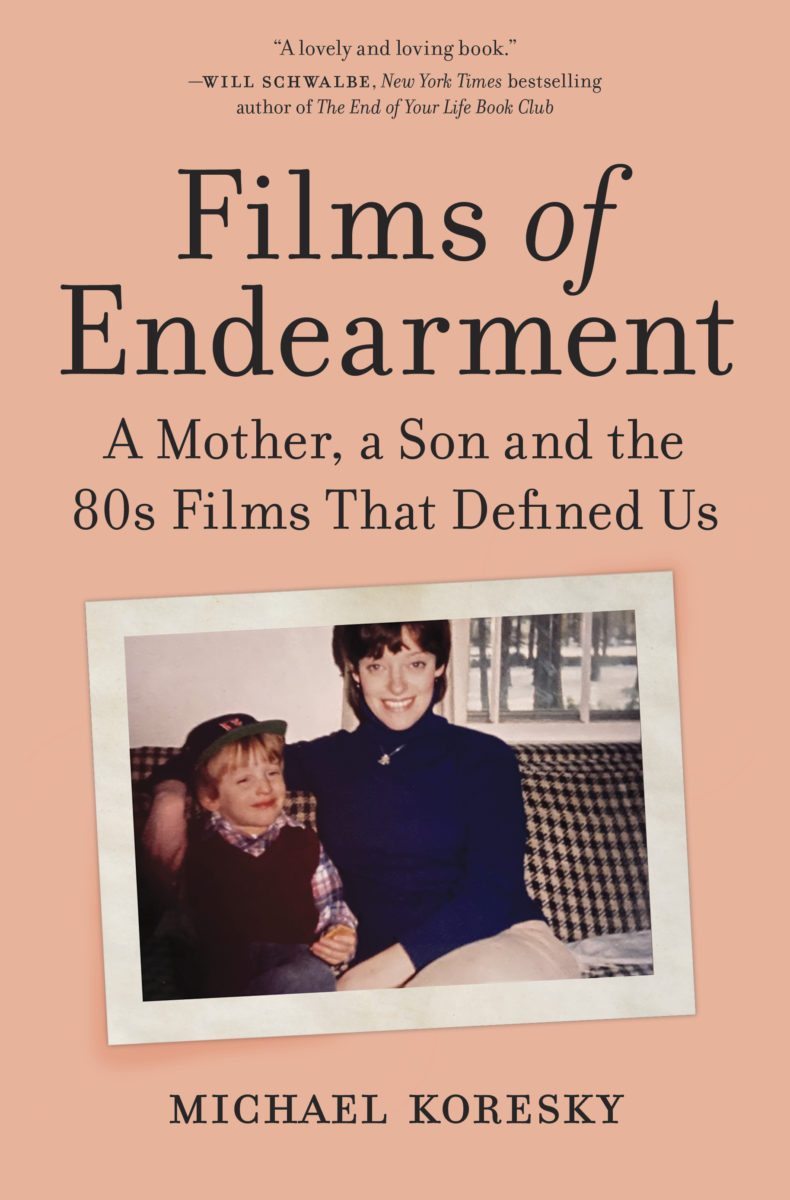
“So much of what I have long known about my mother is from anecdotes connected to the movies,” writes Michael Koresky in his memoir, Films of Endearment. It is a deeply personal book––funny, emotional, and very, very smart––and anyone who connected with a parent through cinema will identify. Koresky uses films as a framing device. These are female-driven stories of strong protagonists, like Nine to Five, Aliens, Terms of Endearment, and even Mommie Dearest. Meanwhile, Koresky documents his mother’s life and outlines his own, stopping along the way to ponder the careers of the likes of Michelle Pfeiffer: “Pfeiffer’s reputation for being private and stand-offish, an understandable defense mechanism in an industry that judges people based on looks, has only deepened the sense of an actor selectively and successfully cultivating her image.” This is an extraordinarily moving book, and one I look forward to reading again. Any film die-hard will identify with Koresky’s thoughts near the book’s end: “It has always annoyed me when someone tells me I talk about movies too much. My response is that talking about movies is talking about life.” (The book is available on May 4 but available for pre-order now.)
Goodbye, Dragon Inn by Nick Pinkerton (Fireflies Press)
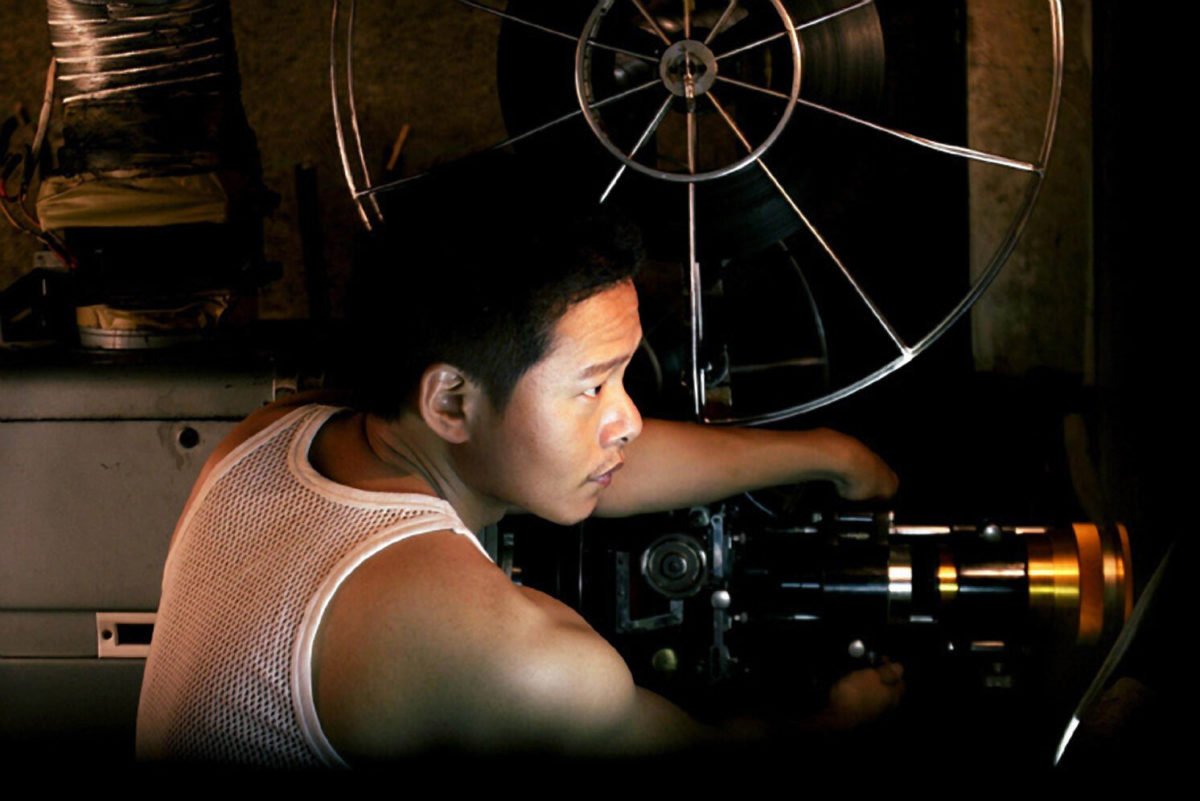
I watched Tsai Ming-liang’s lyrical masterpiece Goodbye, Dragon Inn for the first time a few days before reading Nick Pinkerton’s analysis of the same name from Fireflies Press. And while Dragon is elegantly enticing on its own, Pinkerton’s text makes the film connect on an even deeper level. And as any longtime reader of Pinkerton’s work might expect, the book is also incredibly entertaining. Highlights include Pinkerton’s discussion of his own background with the film (“My grandfather in New Smyrna Beach, Florida saw it of his own volition”), the film’s place in its writer-director’s oeuvre, and a breakdown of Dragon’s unforgettable men’s room vignette (a scene Pinkerton says suggests “a Jacques Tati who has turned his attention to a comedy of cruising manners”). This is surely the first book ever written to discuss Tsai’s work alongside Schrader’s The Canyons, Sega CD’s Night Trap, and Trolls World Tour. Make no mistake, Pinkerton’s book is a must-read for cinema lovers. Note that this is the first release in Fireflies’ Decadent Editions series of 10 books about different 10 films for each year of the 2000s.
Cinemaphagy: On the Psychedelic Classical Form of Tobe Hooper by Scout Tafoya (Miniver Press)
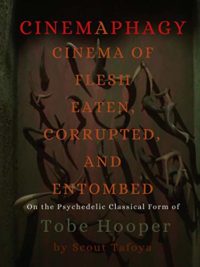
In Cinemaphagy, Scout Tafoya assesses the work of the great Tobe Hooper with intelligence, humor, and curiosity. (I love this definition, found at the book’s start: “Sarcophagy, noun plural sar·coph·a·gy \särˈkäfəjē\ the practice of feeding on flesh.”) Intelligence, humor, and curiosity can all be evidenced in Hooper’s approach to horror, from The Texas Chain Saw Massacre and Salem’s Lot to Lifeforce and his later Masters of Horror efforts. In the book’s introduction, Tafoya explains his thought process behind writing on Hooper, whose “negligible legacy deserved reinforcement, how his work as an artist was overlooked by a culture that despised horror film and its outré signifiers and tonal register, about a director who practically in secret kept alive a rich tradition of effulgent Hollywood film grammar.” Indeed, Cinemaphagy serves as both a reminder of Hooper’s talent and importance and a skillful analysis of a strange career. Tafoya’s comparisons of Texas Chain Saw to Maya Deren’s At Land and his defense of Hooper’s much-maligned The Mangler (“there is nothing wrong with The Mangler that can’t be explained by a lack of money”) show the author is the passionate investigator that his subject deserves.
True Believer: The Rise and Fall of Stan Lee by Abraham Riesman (Crown)
Riesman’s biography of Marvel Comics kingpin Stan Lee feels like the definitive Lee bio. And yet it also serves as a shocking look at a figure whose many talents were often eclipsed by ego, dishonesty, and lapses in judgement. Riesman covers the somber end of Lee’s life in painful detail, and it is hard not to leave the book with a feeling of overwhelming sadness and even anger, at the individuals who took advantage of an icon when he needed help the most. This is a vitally important book. But prepare to feel deeply unsettled.
Conversations With Lav Diaz by Michael Guarneri (Piretti Editore)
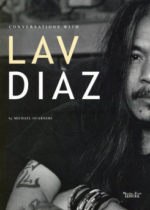
The work of Filipino director Lav Diaz truly warrants endless discussion, and in Michael Guarneri’s Conversations WIth Lav Diaz, that discussion includes the Norte, the End of History filmmaker himself. The book gathers the author’s interviews with Diaz from 2010 to 2020. There are pearls throughout, such as this comment from Diaz in 2013 regarding the look of Norte: “The canvas is the idea. I chose the locations for Norte, the End of History because of the colors, because of the sunlight: I like the way the light keeps changing in the island, I like how the light reflects and affects the mood of the people there.”
In Their Own Words: Fiction Directors edited by Alex Heeney and Orla Smith (Seventh Row)
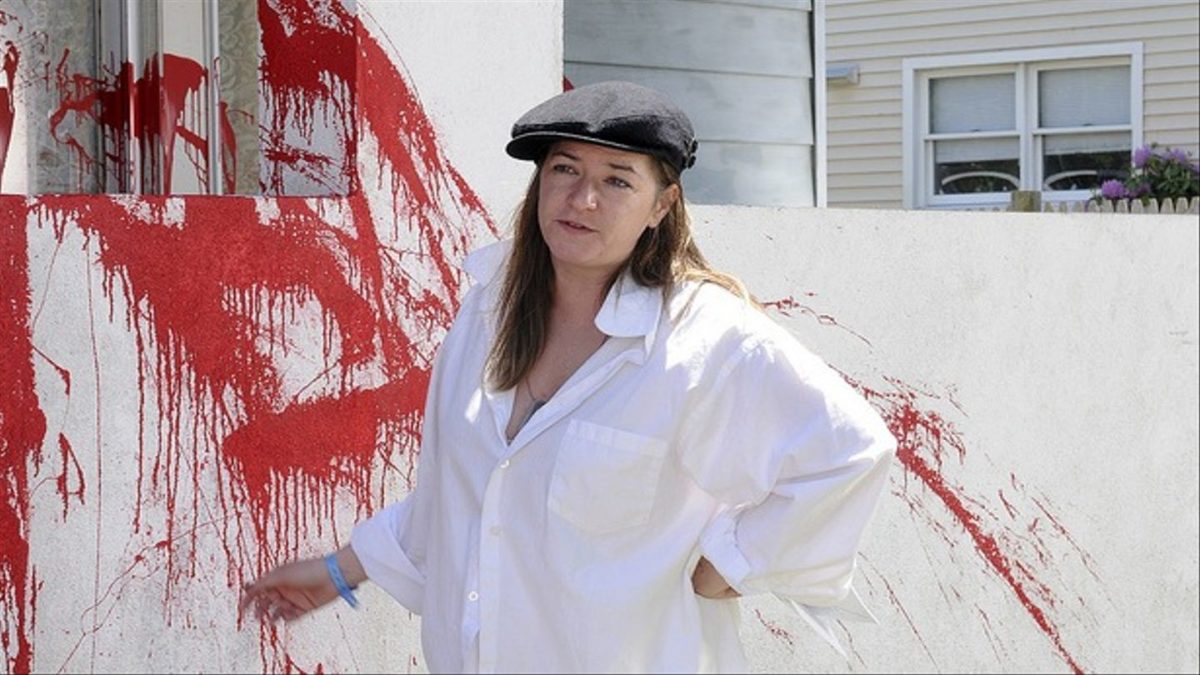
Regular readers of this column should be familiar with Seventh Row, the film publication known for e-books focusing on filmmakers like Mike Leigh and Kelly Reichardt. The latest from editors Alex Heeney and Orla Smith might be Seventh Row’s most ambitious release to date. In Their Own Words: Fiction Directors features a cavalcade of writer-directors tackling questions like “How do you tell complex stories about women?” and “How do you use sound to reflect a character’s subjective headspace?” Yes, the book includes the words of heavyweights like Lynne Ramsay, Olivier Assayas, and Terence Davies. But it also includes new voices like Jeff Barnaby, director of the exhilarating Canadian zombie film Blood Quantum, and The Tale’s Jennifer Fox. There is so much to chew on here. One example? The following thoughts, from Proxima director Alice Winocour: “Now that we’ve been in lockdown, I’ve re-watched those films that were so important to me—Cronenberg’s movies, body horror movies, like Scanners (1981) or Rabid (1977) or Dead Ringers (1988). They have a strange calming effect on me. I don’t know if it’s because of the virus and my hypochondria, because I am really a hypochondriac. But I feel they are, in a way, calming.”
Making Schlesinger’s Midnight Cowboy and Hellman’s Two-Lane Blacktop
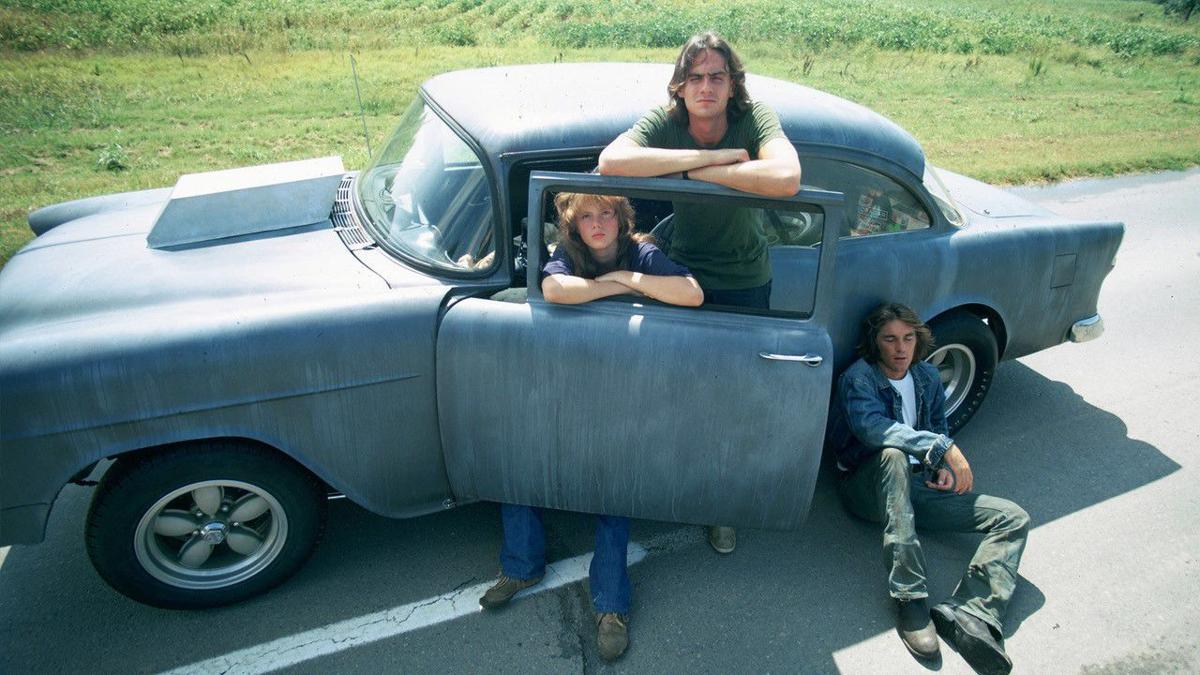
While John Schlesinger’s Midnight Cowboy and Monte Hellman’s Two-Lane Blacktop both qualify as seminal films, the responses to each at the time of release could not have been more different. In Shooting Midnight Cowboy (Farrar Straus Giroux), author Glenn Frankel documents the creation of the grimy, then-shocking story of Joe Buck and Ratso Rizzo, as well as the controversies it caused on its path to Oscar success. Meanwhile, the appropriately titled Bumpy Road: The Making, Flop, and Revival of Two-Lane Blacktop (University Press of Mississippi) by Sylvia Townsend explores how the “existentialist car-racing movie” starring non-actors James Taylor and Dennis Wilson flopped spectacularly. Both Frankel and Townsend have crafted rich, involving texts, and painstakingly explore how the films impacted the careers of all involved, and moviemaking in general. Interestingly, though, while Cowboy shocked the world’s more staid corners and upended the Academy Awards, the influence of Blacktop today is likely just as great. As Wes Anderson puts it near the end of Bumpy Road, “I think it’s better known than ever. It had sort of dropped below the radar for a few years, and now it is back to stay. It is canonized.” Sadly, Hellman passed away on April 20 at the age of 91. But films like The Shooting and Two-Lane Blacktop will live on, and books like Bumpy Road should see his status as an unfairly neglected icon continue to rise.
Wes Anderson: The Iconic Filmmaker and His Work — Unofficial and Unauthorized by Ian Nathan (White Lion Publishing)

As we prepare for the long-delayed premiere of Wes Andeson’s latest film, The French Dispatch, it is worth considering the entirety of his career. Ian Nathan’s Wes Anderson: The Iconic Filmmaker and His Work achieves this task in a delightful manner. Dispatch provides the book with its conclusion, but before then comes a well-researched stroll through the magnificent Anderson’s filmography, starting with Bottle Rocket and Rushmore. There are also handy breakdowns of Anderson’s commercials and short films, gorgeous stills, and lots of lovely set photos. Nathan’s book joins Matt Zoller Seitz’s Anderson tomes, artwork collection Bad Dads, and the recent photo compilation Accidentally Wes Anderson—all featured in past Film Stage columns—on the ever-growing shelf of supremely enjoyable Anderson appreciations.
Letters From Hollywood: 1977-2017 by Bill Krohn (State University of New York Press)
For more than four decades, Bill Krohn was the Los Angeles correspondent for Cahiers du Cinéma, a prestigious role—and one he was more than equipped for. Letters From Hollywood collects 30-plus essays from throughout Krohn’s career. The writing is razor-sharp, and demonstrates that the author is adept at engaging with complex, thorny topics. Krohn’s essay on Friedkin’s Cruising is a fine example. Consider, at the essay’s end, Krohn’s analysis of the film’s conclusion, in which Karen Allen’s Nancy puts on the “discarded leather-boy accoutrements” of Al Pacino’s no-longer-undercover cop, Steve. “[T]he image Steve is seeing in his shaving mirror is of a bisexual body,” Krohn writes. “It could be his own image as a bisexual man, or it could be an image signifying that his relationship with Nancy has been contaminated by the S&M games he’s been playing: Mom has turned into a slightly scary surrogate for Dad.”
This Is How You Make a Movie by Tim Grierson (Laurence King Publishing)
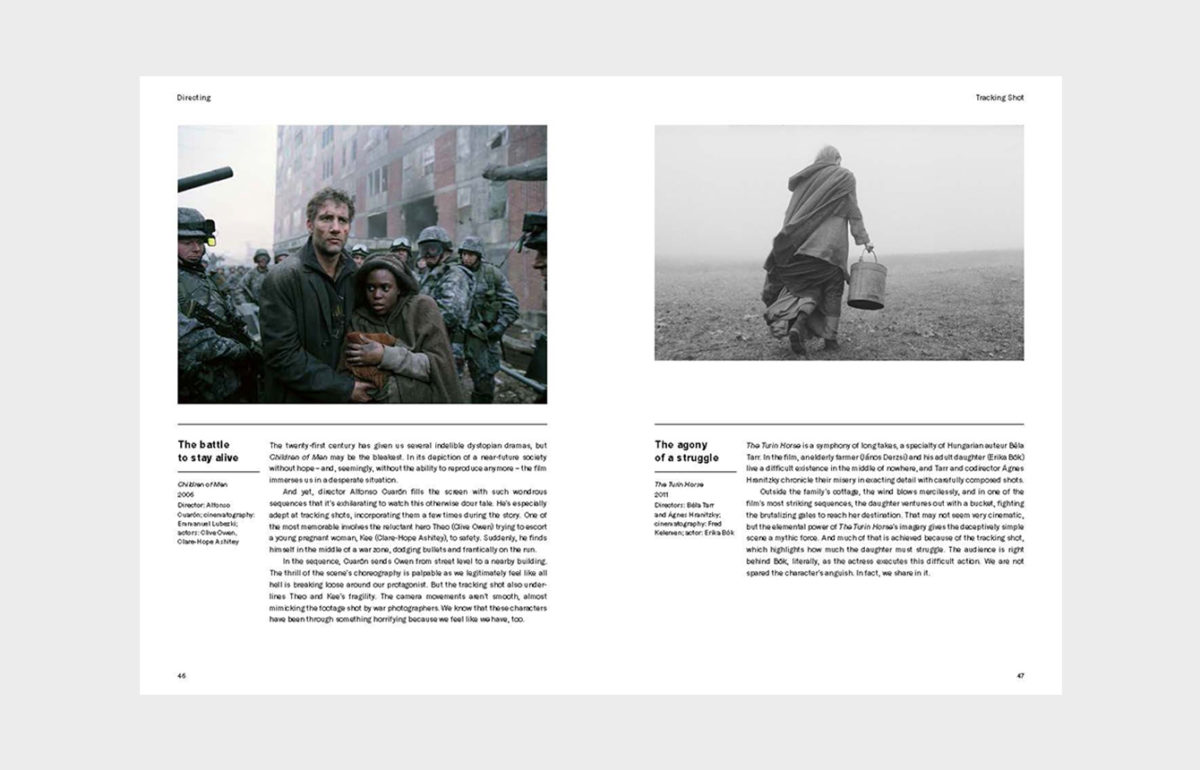
The style of critic Tim Grierson’s This Is How You Make a Movie is simple but startlingly effective. Over nearly 200 pages, Grierson devotes a page each to a film that showcases a different style of acting, directing, editing, writing, and lighting and camera technique. One example is the Safdies’ Good Time, which Grierson slots under the acting heading—in this case, “Motivation,” and “Finding the core of an unlovable character.” “On paper,” Grierson writes of Robert Pattinson’s Connie, “this is a character who would be hard to root for. And yet, Pattinson makes him compelling. No one would describe Connie as ‘lovable,’ but the actor burrows inside him in such a way that this small-time hood has an internal logic that makes sense.” While Grierson covers the films one might expect to see here—The Godfather, Do the Right Thing, All the President’s Men—he also highlights less-obvious gems like Fish Tank, Scott Pilgrim vs. the World, and Two Days, One Night.
New books on NINJAGO, Potter, Yoda, and Raya for wee film fans, and their Delorean-obsessed parents
One of the joys of writing this roundup of film and pop culture-related books is that a great many of them interest my children. OK, not so much the looks at Midnight Cowboy and Two-Lane Blacktop, but definitely the Harry Potter, NINJAGO, Yoda, and Raya. First up are the latest Harry Potter releases from Insight Editions. Crafting Wizardry; Exploring Diagon Alley: An Illustrated Guide (featuring text by Jody Revenson and illustrations by Studio Muti); and Gryffindor Magic and Slytherin Magic are filled with— respectively—family-friendly craft ideas, detailed drawings of spots like Gringotts and Flourish and Blotts, and artifacts like patches, pennants and stationary. As usual, each book is designed with care and crafted with insight. DK’s LEGO NINJAGO Character Encyclopedia, New Edition is another minifigure roundup, this one updated to feature designs and characters from the long-running series’ latest season, while DK’s LEGO Star Wars: Yoda’s Galaxy Atlas is a delightful romp through brick versions of Endor, Crait, and many, many more. It’s also very funny; a poster in the Ahch-To section urges visitors to “GO GREEN with a glass of THALA-SIREN MILK!” Meanwhile, my 6-year-daughter devoured Raya and the Last Dragon releases from DK. Raya and the Last Dragon: Raya’s World by Julia March is a nice look at the world of Kumandra and the people and creatures Raya encounters there, while stickers from The Ultimate Raya and the Last Dragon Sticker Book now adorn items throughout our house. And while it is probably more for adults, my son Back to the Future-mad 10-year-old son was thrilled to dive into Delorean Time Machine: Doc Brown’s Owners’ Workshop Manual (by Bob Gale and Joe Walser), an immaculately detailed study of Doc’s time travel technology and other devices. Been waiting for a breakdown of flux capacitor components? This is the book for you.
Deconstructing the Rat Pack: Joey, the Mob, and the Summit by Richard A. Lertzman with Lon Davis (Prestige Cinema Books)
One of the most fascinating might-have-beens in film history has to be Martin Scorsese’s Dino, an adaptation of Nick Tosches’ Dean Martin biography that famously would have starred Tom Hanks as the immortal singer and actor. If a Rat Pack-centered film is considered again—yes, there was HBO’s so-so The Rat Pack in 1998—Deconstructing the Rat Pack: Joey, the Mob, and the Summit would provide fruitful source material. This entertaining read by Richard A. Lertzman with Lon Davis focuses on the fascinating collision between Martin, Frank Sinatra, Sammy Davis Jr., and Joey Bishop with mob figures like Mickey Cohen, various celebs, and soon-to-be President John F. Kennedy in Las Vegas. Bishop is actually the lead here; the authors interviewed him before his death in 2007. The book is bursting with delightful details; my favorite is Bishop sharing his thoughts on 2001’s Ocean’s 11 remake: “It’s a bunch of bullshit. In our film, we were all friends. Buddies. You can tell that. We had chemistry. Then they make this cheap remake. Crap. Make something original.”
Soon-to-be-adapted: Klara and the Sun by Kazuo Ishiguro (Knopf)

The latest novel from the author of Never Let Me Go and The Remains of the Day is the haunting story of an AF—“Artificial Friend”—and her experience as the companion of a sickly teenager in a dystopian society. It is a genuinely moving page-turner, a book that somehow manages to equal Never Let Me Go. It’s another masterpiece from Ishiguro, and the upcoming film adaptation has the capacity to be extraordinary. (Since finishing the novel, I’ve not stopped pondering its ending, or the mysterious “Cootings Machine.”)
New Blu-rays from Criterion: Going Boating with Beatty and Bong

A handful of Criterion Collection discs recently went out of print, terrible news for those who had not picked up copies of Days of Heaven, Don’t Look Now, Rosemary’s Baby, and Harold and Maude. It was a reminder that one must not hesitate for too long when it comes to Criterions. Three recent Criterion Blu-rays will not be out of print any time soon, but still belong on the must-buy-soon list. First is the late Alan J. Pakula’s masterful Warren Beatty-starrer, The Parallax View. The 4K transfer and 1974 and 1995 interviews with Pakula make this a truly essential purchase. Also unmissable is the long, long, long-awaited release of Jacques Rivette’s Céline and Julie Go Boating. Many cinephiles, myself included, searched in vain for this enchanting, playful stunner for years. Now, it is available at last, and in a glorious, supplement-filled package. My favorite of these is the essay from the always-insightful Beatrice Loayza; she astutely identifies Celine and Julie as “a film of binaries, doubles, and parallel worlds.” And just released on April 20 is a gorgeous restoration of Parasite director Bong Joon Ho’s second film—and first classic—2003’s Memories of Murder. As author Ed Park puts it in his booklet essay, Memories is “a model of controlled storytelling that only appears to be ‘total chaos,’ a film that rewards multiple viewings.” Indeed, like Fincher’s Zodiac, Memories of Murder is an introspective, thrilling film about those tasked with attempting to know the unknowable. Parasite might be Bong’s greatest work, but here is where he forced the world to pay attention to his abilities.
